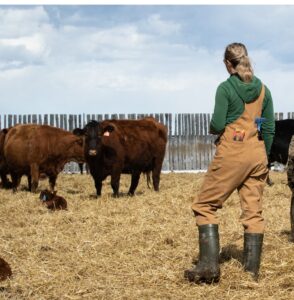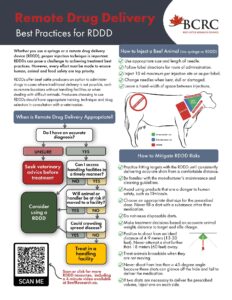Responsible Antibiotic Use on Canadian Cow-Calf Operations 🎙️
CLICK THE PLAY BUTTON TO LISTEN TO THIS POST:
Listen to more episodes on BeefResearch.ca, Spotify, Apple Podcasts, Amazon Music or Podbean.
This article written by Dr. Reynold Bergen, BCRC Science Director, originally appeared in the February 2025 issue of Canadian Cattlemen magazine and is reprinted on BeefResearch.ca with permission of the publisher.

In 2018, over-the-counter sales ended for the few antibiotics (like tetracycline) that were still available in Canadian farm supply stores. The new requirement for a “veterinary-client-patient relationship” (VCPR) before all antibiotics could be prescribed or sold was designed to ensure that the right antibiotics are used in the right animals, at the right dose, at the right time.
Dr. Cheryl Waldner and colleagues from the Western College of Veterinary Medicine have studied the early impacts of these changes (“Antimicrobial Use in Canadian Cow–Calf Herds,” doi.org/10.3390/vetsci10050366, and “Producer attitudes regarding antimicrobial use and resistance in Canadian cow-calf herds,” PMC10581348).
What They Did
They surveyed 168 Canadian producers in the Canadian Cow-Calf Surveillance Network in 2020 (a year after the regulatory change came into full effect). Participants were asked about what antibiotics they used to treat different classes of cattle, and how the regulatory changes had affected their operations. Responses were received from 146 producers, 67% from Western Canada and 33% from Eastern Canada. Since some Western producers had also participated in the earlier Western Canadian Cow Calf Surveillance Network, antibiotic use could be compared over time.
What They Learned
Nearly all cow-calf producers use antibiotics, but they don’t use them often. Nationally, 95% of producers used antibiotics in cows and calves. But only 9% of producers treated more than 5% of cows and only 12% of producers treated more than 5% of their calves.
Antibiotics were mainly used to treat lameness in cows (83% of producers), diarrhea in newborn calves (67% of producers), and bovine respiratory disease (BRD) in pre-weaned calves (78% of producers). But remember – very few producers treated more than 5% of animals for any condition. Overall treatment rates for all three diseases in Western Canada were the same in 2020 as in 2014, though fewer producers treated more than 5% of their calves for BRD in 2020 (17%) than in 2014 (29%).
Most producers (77%) reported no change in their access to antibiotics, 21% said antibiotics were less accessible and 2% said they had become more accessible. Most (63%) reported no change in antibiotic cost; a few (2%) said antibiotic costs had gone down, and 35% said prices had increased. Those who felt that antibiotics had become more expensive were also those who treated more than 5% of their calves before weaning.
Most producers (95%) reported that their antibiotic use practices had not changed since the regulations changed. A few (4%) said they were using less, and only 1% indicated they were using more. Nearly everyone (99%) said the veterinarian was their main source of information regarding antibiotics and appropriate antibiotic use (88%).
What has changed is macrolide use. Injectable macrolide antibiotics used by cow-calf producers include Micotil (and its generic counterparts Hymatil and Tilcomed), Draxxin (and its generic counterparts Increxxa, Lydaxx, Macrosyn, Rexxolide, Tulaven, Tulinovet, Tulissin), Zactran and Zuprevo. These antibiotics are also widely used to prevent and treat BRD in the feedlot. These antibiotics have always been prescription-only; they were never available over the counter. In 2020, 55% of Canadian cow-calf producers surveyed reported using macrolides. In the West, the proportion of producers using macrolides increased from 44% (2014) to 61% (2020), mostly to treat lameness in cows and BRD in calves before weaning.
Although more Canadian cow-calf producers used macrolides in 2020, tetracyclines were still used by more producers (58%) than macrolides (21%) to treat lame cows. 60% of producers used florfenicol (Fenicyl, Florkem, Nuflor, Resflor, Zeleris) to treat BRD in calves before weaning compared to 33% using macrolides.
Macrolides have become more popular for a few reasons. The requirement to obtain antibiotics from a veterinarian means that producers receive solid advice about which product is most appropriate for in any given situation. The recent proliferation of generic macrolide antibiotics has made them much more affordable and cost-effective. Finally, macrolides generally require a smaller dose and are a better fit for dart guns, crossbows and pole syringes. If initial antibiotic treatment failed, producers were more likely to consult with their veterinarian than to try a different antibiotic for diarrhea (74% vs. 71%) and BRD (68% vs. 46%). But they were more likely to try a different antibiotic (53%) than call the veterinarian (49%) when an initial lameness treatment failed.
Bottom Line
An ounce of prevention is still worth more than a pound of cure. Good nutrition and an appropriate vaccination program won’t completely prevent all disease, but they will reduce the number of animals that need antibiotics.
So, What Does This Mean to You?
Review your herd vaccination program with your veterinarian. New oral and intranasal vaccines can be given at birth to help protect against scours and BRD (BRD still needs a booster at spring processing). There is no effective vaccine available for any form of lameness, but footrot responds well to antibiotic treatment. If the first lameness treatment doesn’t work, don’t just switch antibiotics. That throws good money after bad, and the cause is not always infectious. Take advantage of your VCPR. Ask your veterinarian what you’re dealing with and how to treat it effectively.
The Beef Cattle Research Council is a not-for-profit industry organization funded by the Canadian Beef Cattle Check-Off. The BCRC partners with Agriculture and Agri-Food Canada, provincial beef industry groups and governments to advance research and technology transfer supporting the Canadian beef industry’s vision to be recognized as a preferred supplier of healthy, high-quality beef, cattle, and genetics. Learn more about the BCRC at www.beefresearch.ca.
Click here to subscribe to the BCRC Blog and receive email notifications when new content is posted.
The sharing or reprinting of BCRC Blog articles is typically welcome and encouraged, however this article requires permission of the original publisher.
We welcome your questions, comments and suggestions. Contact us directly or generate public discussion by posting your thoughts below.
